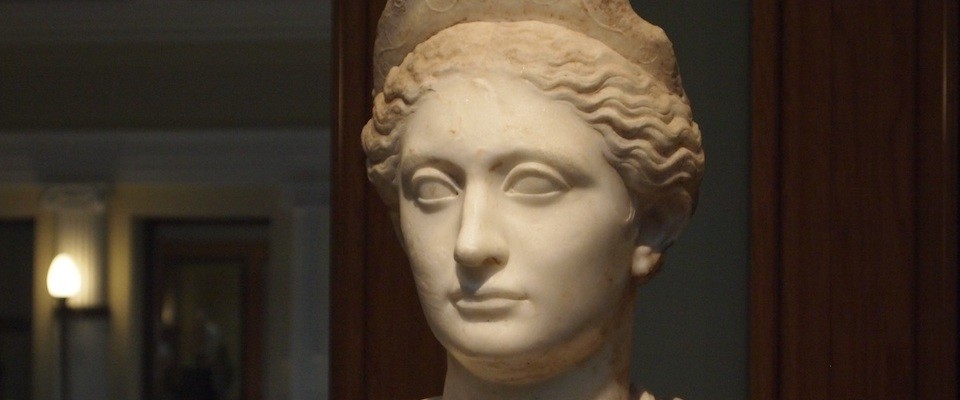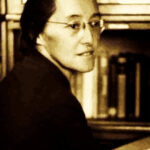
Published April 1, 2023
What is a woman’s place in society? Down the centuries, from Plato and Aristotle to Margaret Sanger and Ruth Bader Ginsburg, certain patterns are discernible in how this question has been answered. The most cogent answers, offered in a variety of historical and economic circumstances, integrate three basic aspects of who we are as human beings. First, we are rational creatures ordered to excellence. Second, we are a species differentiated asymmetrically by sex. Third, we are unique individuals, each with our own peculiar gifts and personal agency. When one (or more) of these three aspects of human personhood is neglected or denied, the full flourishing of women and men alike is threatened. Fortunately, modern sex discrimination law integrates these three aspects of personhood. Theorized properly, this area of law provides a true account of the sexually dimorphic individual human person, which in turn provides the basis for a new sex-realist feminism. It’s an account worth fighting for.
Before the advent of modern sex discrimination law, the prevailing account of women’s nature was biologically deterministic. One need not dig very deeply into early American legal history to find laws that restricted women as a class from participating in public-minded activities due to their “biological function” and resulting unfitness. The most notorious case is Bradwell v. Illinois (1873), which upheld a state statute prohibiting married women from practicing law. In Bradwell, Justice Joseph Bradley wrote for the Court: “The natural and proper timidity and delicacy which belongs to the female sex evidently unfits it for many of the occupations of civil life. The constitution of the family organization, which is founded in the divine ordinance as well as in the nature of things, indicates the domestic sphere as that which properly belongs to the domain and functions of womanhood [my italics].” Variations of this phrasing—“biological function,” “reproductive function,” “the function of womanhood”—were long employed in U.S. law to disparage women’s capacities and curtail their participation in public life. Legally, that era came to an end only in the second half of the twentieth century: In 1964, Title VII outlawed employment discrimination, and in 1972 the Supreme Court struck down an Idaho law arbitrarily preferring men to women in the administration of estates.
The idea that a woman’s “biological function” ought to determine her social and familial role was not unique to American law, of course; it is a very old idea, with an Aristotelian pedigree. To understand its flaws, one must see not only what Aristotle got wrong but also what he got right. Aristotle defined the excellence of a thing by the thing’s distinctive function. Just as the excellence of an eye is found in its operating well according to its seeing function, and the excellence of a lyre-player in his playing the lyre well, so the excellence of the human being, Aristotle tells us in Book One of the Ethics, lies in his fulfilling his highest—rational—function, which is to live in accord with virtue. For his flourishing and happiness, then, the human being ought to live virtuously, properly oriented to his highest end.
But even if, for Aristotle, both men and women are human, both basically rational, and therefore both designed to live virtuous lives, men and women differ fundamentally on the basis of their reproductive or biological function. Indeed, it is precisely this function that differentiates the sexes. According to Aristotle, this difference is politically fundamental: Woman’s childbearing function determines her distinctive domestic role, by which she is perfected in virtue. Restricting women to this role, Aristotle writes in the Politics, is for the common good of the household and ultimately of the city. Whereas men are meant to practice virtue—and thereby find perfection—both inside and outside the household, women reach their perfection only inside the household. Women can achieve a kind of feminine excellence in the governance of the household economy (oikonomia), a role delegated to them by their husbands. But for Aristotle, women’s rational capacity is deficient, as the female is a deficient male (a view likely traceable, at least in part, to Aristotle’s flawed biology). So, whereas male citizens rule and are ruled in turn, women are always only ruled by men. Women therefore lack both the capacity and the leisure to take part in the public deliberations of the city.
There is much to commend in Aristotle’s rich discussion of the deeply interdependent and politically essential household: his view of the spousal relationship as potentially a virtuous friendship; of children as the good common to parents that best holds the spousal couple together; and of the polis as a union of families, which are in themselves ultimately insufficient. But very little separates Aristotle’s account of women’s distinctively domestic function from that of Justice Bradley in 1873. Both accounts circumscribe woman’s place according to her reproductive function and the deficiencies that seem to accompany it.
Sex discrimination law rejects just this account. As an ACLU attorney, the late Justice Ruth Bader Ginsburg was chiefly responsible for convincing the Supreme Court in the early 1970s that laws that discriminated on the basis of sex were in violation of the equal protection clause of the Fourteenth Amendment. Ginsburg successfully argued that it was unreasonable for laws to classify all women according to the “biological function of motherhood,” or otherwise to judge individual women unfit for publicly minded activities due to assumptions about their capacities as a class. Ginsburg asserted, rightly in my view, that the Court ought to distinguish between, on the one hand, those laws and policies that are genuinely and licitly protective of pregnant women and the caregiving function of the family, and, on the other hand, those which arbitrarily discriminate against individual women (or men) on account of their sex.
In 1972, Ginsburg convinced a unanimous Supreme Court that there is no reason why women— simply because, as a class, they have the capacity to be mothers—cannot exercise their capacities as lawyers or administrators of estates. Ginsburg thus bequeathed to sex discrimination law an account of women as rational individuals, rather than mere members of the class of “potential mothers.” Dorothy Sayers had once called for such an account in her 1938 essay “Are Women Human?”: “What is repugnant to every human being is to be reckoned always as a member of a class. . . . [But] what women as a class want is irrelevant.” If a woman wants to know about, say, Aristotle, Sayers wrote, “nothing in my shape or bodily functions . . . need prevent me from knowing about him.” Likewise, Edith Stein argued in two speeches, also in the 1930s:
No woman is only woman; like a man, each has her individual specialty and talent, and this talent gives her the capacity of doing professional work, be it artistic, scientific, technical, etc. . . . The strong individual differences existing within both sexes must be taken into account. . . . It seems right, therefore, that no legal barriers of any kind should exist.
To the extent that it upholds this account, sex discrimination law is true to the nature of human personhood. Unfortunately, Ginsburg and her fellow abortion advocates have betrayed the account that Ginsburg herself established. They have argued that abortion rights are required by sex discrimination law. To support this claim, they have promoted flawed theoretical accounts of human nature. Therefore, giving a proper theoretical grounding to the advances of sex discrimination law—and giving a proper historical context to the emergence of these insights—will not only help shield abortion prohibitions from spurious litigation; it also can help us understand ourselves better as sexually dimorphic creatures, for whom sexual embodiment is fundamental, but not determinative.
If Aristotle erred in disparaging the rational capacities of women by overemphasizing the bodily differences between male and female, Ginsburg’s modern feminism errs in bracketing our bodies and the biological asymmetries of sex. This error is not unlike that of Aristotle’s teacher, Plato. His Republic would seem to affirm the social equality of the sexes, but only by prescinding dualistically from their bodies, leaving the city to manage politically—and inhumanely—the asymmetrical consequences of sex.
In the Republic, Socrates asserts that male humans “mount” like dogs (and are physically stronger), while females bear the offspring; but apart from these basic biological differences, sex is said to be mostly superficial, akin to the differences between bald and long-haired men. Elite women responsible for governance should be afforded education and work according to their talents, just as men are—and just as anti-discrimination law requires today. But to achieve parity of public position, these elite women will need, Socrates says, “an easy-going kind of childbearing.” With their mates selected for best breeding, elite women will have their children quickly swept away from them and cared for by wet nurses and governesses—whose own children, if “ordinary,” will need to be euthanized “if the flock is going to be of the most eminent quality.” Professional equality thus comes at a great cost, to the elite women themselves, to their caregiving servants, and to young children. Public roles are doled out by merit, but the intimate life of the family—and many human lives—are sacrificed to the good of the city. As in today’s feminist advocacy, universal childcare and abortion (and in antiquity, also infanticide) are necessary to the sex-equalizing scheme.
At one extreme, then, Aristotle holds that women’s reproductive function and deficient reason subordinate them legally and politically to men, relegating them to the private sphere; at the other, Plato implies that women’s reproductive function is a hindrance to their full social and political equality, but one that can be managed with the right political solution. Yet well before modern feminism, which follows Plato’s radical scheme, we find powerful voices who reject the Aristotelian account of women’s contribution as determined by their reproductive function, but who do not go the way of Plato (or modern feminism) in seeking to free them inhumanely from it. Advocates of women’s social equality such as Christine de Pizan in the fifteenth century, Mary Wollstonecraft in the eighteenth, the early women’s rights movement in the nineteenth, and Edith Stein and Dorothy Sayers in the early twentieth, recognized the great good of women’s childbearing function. They also understood that women were, like men, fully rational creatures with a common human purpose.
An Italian widow and mother, Pizan made her living as a learned writer in the Court of King Charles VI of France. In her Book of the City of Ladies (1405), she explicitly rejected the Aristotelian account of the sexes that pervaded the anti-woman satires of her time: “[God] endowed both male and female with this soul, which he made equally noble and virtuous in the two sexes. . . . Human superiority or inferiority is not determined by sexual difference but by the degree to which one has perfected one’s nature and morals.” Nearly four centuries later, in her Vindication of the Rights of Woman (1792), Wollstonecraft similarly urged women, confronting a stultified Rousseauian account of feminine virtue, “to rise in excellence by the exercise of powers implanted for that purpose” by God. Granting that women and men “may have different duties to fulfill”—duties that give rise to distinctive maternal and paternal characters—Wollstonecraft argued that such duties “are human duties, and the principles [or virtues] that should regulate the discharge of them . . . must be the same.”
The Christian response to sexual asymmetry, endorsed implicitly by Pizan and explicitly in Wollstonecraft’s Rights of Woman, was a crucially humane alternative to the Republic’s. It channeled sex into lifelong monogamous marriage, so that women were not left alone with the unequal burdens of sex. As belief in the imago Dei began to elevate women and children relative to their status in antiquity, Christian sexual mores demanded the same chastity of men as of women.
But Pizan and Wollstonecraft’s shared vision of equal dignity, reciprocity, and collaboration between the sexes was jeopardized—and their critique of gender inequities further justified—as the industrial revolution took hold. After all, during the premodern era, the struggle for material subsistence helped to harmonize the physical and reproductive asymmetries between the sexes, as mere survival required a profound collaboration in the agrarian household. To be sure, men and women made distinctive—gendered—contributions in the family, but before industrialization nearly all work might be considered “domestic work,” part and parcel of the sustenance and management of the interdependent and productive household. The assets of the family were owned in common—rather than by any individuals in the family—and a married woman often worked side by side with her husband in his business enterprise, learning his craft or trade and taking full responsibility for family affairs upon his absence or death.
Customary law in many localities also enabled married women to conduct the business of their own crafts or trades, offering them, as medievalist Eileen Power wrote in 1926, “a full share in the private rights and duties arising out of the possession of the land . . . in spite of the handicap of low wages and sometimes masculine exclusiveness.” Men certainly had legal authority over their wives at this time, but women often enjoyed governance of the capacious household, the delegated management of the oikonomia that Aristotle first recognized. Some women were even known to rule as great queens and abbesses.
The rise of liberalism and industrial capitalism transformed all this, bringing forth manifold material advantages, but more pronounced sexual asymmetries too. As “economics” left the household, men became the primary economic actors. Political theorist Arlene Saxonhouse writes that in liberal theory, wherein both political and economic (public and private) realms become “arenas for male activity . . . the female, whose previous stature had been guardian of the private realm, was denied any significant place in the portrait of society.” Though the early movement for women’s rights in the late eighteenth and nineteenth centuries was coincident with—and so is usually regarded as an aspect of—the rise of liberalism, it was also a reaction against liberalism, which cleaved home from work, public from private, and man from woman. Though the development of sex discrimination law was still a century away, the revolutionary economic and political transitions of the modern era meant that the reciprocal relations between the sexes required by the agrarian economy would not hold for long.
By the time of William Blackstone’s writing of the Commentaries on the Laws of England in the late eighteenth century, married (and unmarried) men had been transformed into (potentially) “rights-bearing individuals,” whereas married women were denied any legal recognition or voice of their own. Under the common law doctrine of coverture, articulated sharply by Blackstone and incorporated unyieldingly into state law, American women were denied a common share of marital property despite their economically productive work in the home. Except in Louisiana, where civil law prevailed, all property was legally held in the husband’s name; he also represented his wife politically. Should husbands be libertine or unkindly men, women had little or no recourse in law or custom; they were entitled, as Blackstone put it, “to no power, but only reverence and respect.” The law, of course, provided no assurance of the latter. Women were first bartered by their fathers (assuming they could offer a dowry); then in marriage, the doctrine of consortium secured the husband’s “marital right,” which meant women’s bodies were no longer their own.
Within less than a century, industrialization had transformed the work of the home. Women’s productive labor of clothes-spinning, to take but one example, gave way to the wage-dependent (and consumerist) practice of clothes-purchasing. The new economic dependence of men upon industrial capitalists left married women increasingly dependent upon their wage-earning husbands, and therefore far more vulnerable to their exploits in the new cities’ bars and brothels, and to abandonment and bad behavior generally. Women’s legal subordination, which had gone virtually unchallenged during a time of subsistence living and existential interdependence, exacerbated the difficulties facing women. Should they wish to protect themselves and their children from alcoholic, abusive, or otherwise profligate husbands (recall that the nineteenth-century temperance movement was predominantly a women’s campaign), the law offered almost nothing; children legally belonged to their fathers, so to leave an abusive marriage was to abandon one’s children. In any case, without their own wages—discriminatory laws such as the one upheld in Bradwell were ubiquitous—mothers had little means with which to provide for themselves and their children.
Thus, industrialization’s sharp fissure between home and work brought the sometimes harsh realities of sexual asymmetry to the fore in an altogether new way. Here we begin to see the emergence of what would eventually be called feminism, a movement dedicated to ensuring that women’s distinctive needs and interests (and those of their children) were met in an industrializing society that seemed increasingly hostile to them. The early women’s movement in the United States first sought better recognition of the still immensely productive work of the household through legal claims for joint property ownership (claims that would not be secured for a full century). As women were forced into the industrial workplace, the movement fought for just workplace laws and protections, and eventually for the franchise (referred to by the Woman’s Christian Temperance Union as the “home protection ballot”). As Wollstonecraft had nearly a century earlier, the movement also agitated strongly in favor of a single moral standard when it came to sex, demanding in particular the right to say no to sex in marriage (against laws that, until the 1980s, failed to criminalize marital rape).
Women’s rights advocates in the late nineteenth and early twentieth centuries sparred internally over whether their times called for women to be treated first and foremost as individuals, the way the emergent liberal philosophy treated men, or as members of families, with special responsibilities to their children. Each perspective had a point, and the tensions and arguments between them inspired many of the workplace reforms of the late nineteenth and early twentieth centuries. Decades later, anti-discrimination law would account for both perspectives: Women could not be excluded from employment opportunities on account of their sex, but employers could accommodate women’s greater responsibility in childbearing. This balance offered important relief to poor and working-class mothers like Ida Phillips, the successful litigant of the first Title VII case in 1971, whose income, due to her husband’s alcoholism and neglect, was the only sure means of provision she and her seven children enjoyed.
But even as the women’s rights advocates of the late nineteenth and early twentieth centuries were responding to liberalism and industrialization with calls for equal civil and political rights, just treatment in the workplace, and chastity on the part of men, Plato’s ancient response to sexual asymmetry re-emerged in the thought and work of Margaret Sanger. In Sanger’s view, just labor laws, workplace protections, and marital rights were mere “palliatives.” To free women from the consequences of sexual asymmetry, society had to address the source of women’s inequality and immiseration: the fertile female body.
Sanger’s wildly successful campaign for birth control radically reoriented our cultural response to sexual asymmetry. Sanger was a paradigmatically modern thinker, in that she offered a technological “solution” to the asymmetries in human reproduction. In short, Sanger cast aside the moral, social, and legal responses toward which nineteenth- and early twentieth-century women’s rights advocates had steadily worked, and about which Pizan, Wollstonecraft, and others had theorized. Instead of privileging a single sexual standard and legal and social supports for women, as nineteenth-century women’s rights advocates had, Sanger insisted upon the individual woman’s social “duty” to control her own fertility technologically. Freed from the consequences of their fertility, women could finally be freed from the burdens of sex—just as men seemed to be.
Twentieth-century feminist theorists followed Sanger’s response to reproductive asymmetry, orienting their complaints around the female body and their solutions around technology. Simone de Beauvoir led the charge, seeing the technologies of birth control and abortion as ways of freeing women from the immanence of their animal bodies and directing them toward sexual transcendence; Kate Millett dismissed the single sexual standard of the early feminists as “naive,” explicitly advocating for a “permissive single standard of sexual freedom”; Shulamith Firestone identified artificial reproduction as the key to ultimate freedom from reproductive asymmetry; Judith Butler altogether rejected the sexed body as given. With her ardent advocacy of abortion as a sex equality right, Ginsburg joined the twentieth-century feminist chorus, and when appointed to the Court, was raised to its first chair.
If the modern feminists’ first error followed Plato in abstracting inhumanely from our sexed bodies such that abortion might be considered an equalizing remedy for asymmetry, the second error applies to what it is to be human. Concerning the relation between the sexed body and the rational soul, all these thinkers were, whether consciously or not, in the dualist tradition of Bacon and Descartes. To the Cartesian, the body’s machinery (and various functions) are but tools the rational individual mechanistically employs and seeks to control according to his or her will. The advent of relatively effective birth control seems to confirm the mechanistic view: No longer “chained . . . to her place . . . through the maternal functions of her nature,” as Margaret Sanger put it, woman can (and, for Sanger, must) exert total control over her reproductive function. That function no longer defines her; she will define it, according to her own individuality, unsexed as she now may seem to be.
Like Plato and Descartes, Sanger and her heirs were right to foreground the common rational capacity of men and women. But the modern feminist account misfires by undermining a proper understanding of each human person as a particular unity of sexed body and rational soul. Though rightly wishing woman to be duly recognized as human, they misconstrue what it is to be human. As Aristotle taught, the rational (human) soul enlivens and unifies the embodied individual as the complex, multi-faceted person he or she is, governing and directing the person to his or her human end. Our sexed bodies are not mere appendages of our minds: As Pope John Paul II explained, they express who we are as human persons, a reality that cannot be mechanistically (and technologically) willed away, as hard as we may try.
The fact that (in Aristotle’s terminology) females reproduce inside themselves and males outside, does not tell us everything about the person. But our “reproductive function” does tell us something, and something fundamental, given that we humans are our sexed bodies. Every human person is either male or female, because to be human is to be embodied and dimorphically sexed. Consequently, female and male experiences of sex and contributions to reproduction are distinctive and asymmetrical, as are maternal and paternal responsibilities to children. But our sexed bodies (and their functions) are human bodies, oriented to our human end, and thereby to our human flourishing. As sexually dimorphic rational creatures, then, each person attains his or her excellence by living according to that highest rational function—as mediated by his or her sexed embodiment and the myriad responsibilities that obtain because of it.
If modern feminism’s first two mistakes are about what it means to be sexed and human, its third error is at the level of the individual and his or her agency. Modern feminists, viewing women’s reproductive function as the source of their subordination, imagine that male reproductive function is the ideal state: We should all have the capacity to have sex without the consequence of pregnancy. With this move, they combine into one the errors of our ancient philosophers: Aristotle, who regarded the male as the normatively human of the two sexes; and Plato, who sought the equality of the sexes by abstracting from their difference. But reproductive functioning that results in pregnancy—unlike every other bodily function of the human being—is achieved through the union of female and male reproductive functions. As such, pregnancy properly implies shared parental responsibilities, even as it makes more profound demands upon (and offers more profound privileges to) the woman with child. When a woman is pregnant, our law justly protects her from workplace discrimination as she seeks to carry out her duties to nurture, protect, and provide for her child. Our law also ought to ensure that the child’s father carries out his reciprocal duties to her and their child.
How, in light of this history, should we understand current battles over sex discrimination law? After all, since the overturning of Roe v. Wade, several state courts have halted new abortion restrictions on the grounds that such restrictions discriminate against women. Some pro-lifers might be tempted to think the answer lies in discarding laws against sex discrimination.
They should think again. In the first place, anti-discrimination law does not prohibit discriminating between the sexes (as it does among the races). As Ginsburg maintained in her 1996 opinion for the Court in United States v. Virginia, “‘inherent [physical] differences’ between men and women, we have come to appreciate, remain cause for celebration.” Instead, anti-discrimination law prohibits discriminating against women (or men)—denigrating or “artificially constrain[ing]” the individual on the basis of his or her sex. A prohibition on elective abortion implicitly maintains that an expectant mother—like an expectant father—owes duties of care to her unborn child such that she cannot legally end the child’s life. That prohibition denigrates women only if one holds a priori that woman’s distinctive reproductive function is itself denigrating of women. Law (and culture) may have a more difficult time enforcing paternal duties to nurture, protect, and provide for children, but we do not allow fathers to end the lives of their unborn children when their paternal duties become too onerous, or are unchosen. We should seek to enforce those duties to the fullest extent possible. Current sex discrimination claims against abortion laws suggest that restricting a woman’s right to an elective abortion is no different from restricting a man’s right to a medical procedure that is unique to men. But we can readily and rationally distinguish between the cancer removed from a man in surgery and the human child removed from his or her mother in elective abortion. The first justly restores the man’s health; the second intentionally (and unjustly) ends the dependent child’s life.
In a society that properly values the goods of the family over the market, most mothers of young children will indeed seek to prioritize the work of the home, whereas fathers will wish to support that work by their investment outside of it. In fact, this division of priorities remains common in American society today. But as Aristotle saw, for the good of the family, each member assists the others by “throwing their peculiar gifts into the common stock.” Thus, in a post-industrial economy in which women are as educated as men, and younger fathers are increasingly invested in engaging actively in the care, nurture, and education of their children, determining who-does-what-when with her or his peculiar gifts requires a practical wisdom that mothers and fathers must employ for the good of the family. Legally constraining that determination from without encourages employers to punish fathers who, for instance, request leave or other accommodations to provide their families with care (rather than with money alone). Illicit sex stereotyping also presumes that mothers are less competent or committed to their professional work than are men or childless women (despite the fact that they often need income from their work in order to care for their children). Sex discrimination law therefore rightly distinguishes between policies that properly advance and protect the goods of the family in caregiving and of women in childbearing, from those laws that arbitrarily discriminate against men or women on account of their sex.
Although Plato and some forms of feminism inhumanely abstract from sexual difference in their quest for equality, the same sources shed important light on the rational nature men and women share. That nature is properly ordered, Plato thought, to excellences of soul. And as Aristotle saw—despite his erroneous conclusions about female irrationality—our nature is a deeply integrated union of the sexed body and rational soul. Taken together in this way, Plato and Aristotle lay the groundwork for a new sex-realist feminism, one undertheorized in sex discrimination law but present there nonetheless. Men and women are sexually dimorphic manifestations of the same kind of being: a rational creature ordered to excellence. Each human being is an integrated and personal unity, distinct from every other individual who will ever live. Our law—if it is to govern us in all our multi-faceted nobility—must be fashioned to honor our shared humanity, recognize our sexual asymmetry, and provide room and scope for our irreducible individuality.
EPPC Fellow Erika Bachiochi is a legal scholar specializing in Equal Protection jurisprudence, feminist legal theory, Catholic social teaching, and sexual ethics. She is also a Senior Fellow at the Abigail Adams Institute in Cambridge, MA, where she founded and directs the Wollstonecraft Project. Her newest book, The Rights of Women: Reclaiming a Lost Vision, was published by Notre Dame University Press in 2021.












